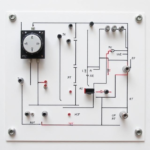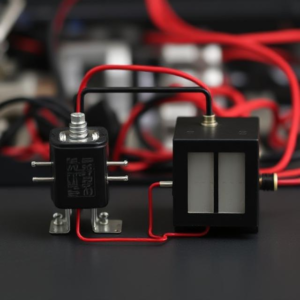Alternating Current (AC) is the type of electrical current that changes direction periodically, unlike Direct Current (DC) which flows in only one direction. Understanding AC behavior requires knowing some key terms: RMS, Peak, , and Phase. These concepts help us analyze how AC circuits work, predict their behavior, and design electrical systems safely and efficiently.

1. Peak Value
The Peak value of an AC signal is simply the highest instantaneous value (maximum magnitude) of the voltage or current during one cycle. Since AC voltage or current changes sinusoidally (like a wave), it moves from zero up to this maximum positive peak, back through zero, down to a negative peak, and returns again.
-
If you look at the graph of an AC voltage over time, the peak is the highest point on the wave.
-
For example, if the peak voltage is 170 volts, the waveform swings from +170 V to -170 V.
Knowing the peak value is important because it tells you the maximum stress or voltage the circuit components will face.
2. RMS Value (Root Mean Square)
The RMS (Root Mean Square) value is the most important and practical measurement of AC voltage or current. It represents the equivalent DC value that would deliver the same amount of power to a resistive load.
Why do we use RMS? Because AC voltage varies continuously, just knowing the peak value doesn’t tell us how much energy or power the AC can deliver on average. RMS helps us compare AC and DC on a common scale.
-
To calculate RMS for a pure sine wave:
-
So if the peak voltage is 170 V, the RMS voltage is about 120 V.
Household AC voltages are usually given as RMS values (e.g., 120 V RMS or 230 V RMS), because it reflects their real usable voltage.
3. Frequency
Frequency tells us how fast the AC signal completes one full cycle of its waveform in one second.
-
Measured in Hertz (Hz).
-
1 Hz means one cycle per second.
-
Common power supply frequency worldwide is 50 Hz (Europe, Asia) or 60 Hz (USA, Canada).
A higher frequency means the wave oscillates faster. Frequency affects how inductors and capacitors behave in circuits, as they react differently to different frequencies. It also influences the design of transformers, motors, and electronic devices.
4. Phase
Phase describes the relative position of one AC waveform compared to another at a given point in time.
-
Expressed in degrees (°) or radians.
-
One full cycle equals 360°.
-
Two AC signals with the same frequency can be shifted in time — this difference is called the phase difference.
For example, if two sine waves are identical but one reaches its peak a little earlier, they are said to be “out of phase.” Phase difference is very important in AC circuits with multiple sources, such as in three-phase power systems or circuits with capacitors and inductors.
Phase determines whether waves reinforce each other (constructive interference) or cancel out (destructive interference).
Summary
| Term | What it Means | Why It Matters |
|---|---|---|
| Peak | Maximum instantaneous value of AC voltage/current | Shows max voltage/current components must handle |
| RMS | Effective DC equivalent voltage/current | Tells actual power delivered; used for ratings and safety |
| Frequency | How many cycles per second the AC completes | Affects circuit behavior and device design |
| Phase | Time shift between two AC signals | Critical for multi-source systems and AC power quality |
Why These Terms Matter in AC Circuits
-
Peak values help engineers choose insulation ratings and protective devices.
-
RMS values are used to calculate power consumption and billing in households.
-
Frequency affects how inductors and capacitors respond, which influences filtering, tuning, and motor speed.
-
Phase relationships determine how multiple AC sources interact, affecting power delivery and efficiency.
Together, understanding these terms lets you analyze AC circuits accurately—whether designing transformers, troubleshooting power supplies, or studying electronic devices.











